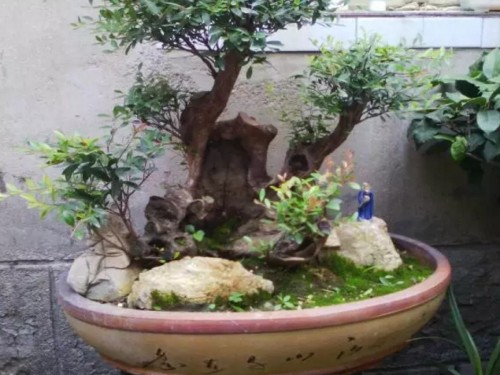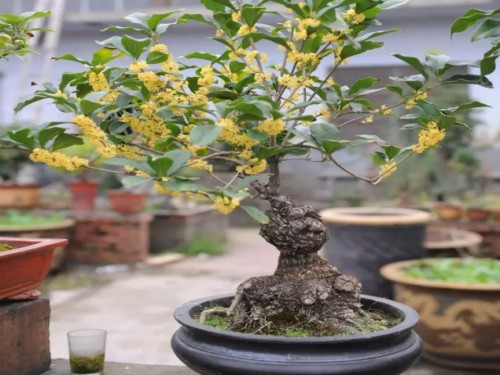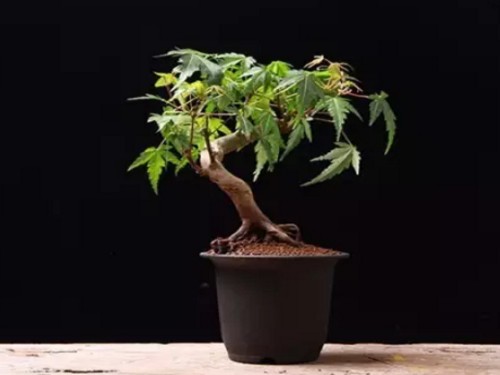Maintenance method of Chinan bonsai
The plant type of Chinan has a unique ornamental value, putting bonsai at home can not only improve the quality and beauty of the room, but also improve the fengshui situation of the room, so that everyone has a healthy physique.
After more than ten years of observation, the excellent basin ability of the red nan growing at the lower altitude is stronger than that of the high altitude; the excellent basin ability of the dark leaf color is stronger than that of the light leaf color; the excellent basin ability of the small leaf is stronger than that of the large leaf; the ability of the leaf-shaped tip is stronger than that of the leaf-shaped circle.
The reasons for the failure of pot cultivation are as follows: first, improper picking and digging of tree stump, and second, improper primary embryo culture. A good bonsai must start from digging piles and pay attention to the protection and maintenance of roots and branches. If you buy it on the market, you must choose piles with healthy branches (new branches have sufficient length) and bright skin colors.

It has been more than 30 years since it was found that Chinan is a good tree species for bonsai. People like it because of its natural ornamental beauty. The roots, stems, branches and leaves of Chinan are unique and unparalleled. People are afraid of Chinan because it seems difficult to raise. If the water and fertilizer management or pruning is improper, it will easily lead to chlorosis, Xinjiang seedling disease, and even direct death. So for many years, people have been in a contradictory state of mind that the more they love Chinan, the more they hate them.
The reason is that for a long time, Chinan bonsai has not summed up a set of mature and effective methods from pile picking, pruning, and later conservation, while our colleagues in bonsai generally only pay attention to bonsai modeling and do not pay enough attention to conservation. in addition, misled by some information, most people who like bonsai often suffer from pathological changes and death due to the lack of correct maintenance guidance. As this phenomenon often occurs, it forms a fixed illusion in people's minds with the accumulation of time, that is, Chinan is "difficult to feed".
In fact, according to our years of practice and experience, the maintenance of Chinan can follow the following practices:
1. Loose basin soil or medium should be used.
2. Attention should be paid to maintaining humidity. At present, the watering of potted plants which are common in some materials should be dry and wet, and it is not suitable to be used in the maintenance of alpinia chinensis.
3. Change the basin at the right time.
4. it is appropriate to store branches in a certain degree, so it is not suitable to grow too long. There is a method of pruning, it is appropriate to use the method of thinning and storing branches, and cutting pieces to keep branches. It is not suitable to use the method of trunk cutting and branch storage, if the method of stem cutting and branch storage is adopted, the thickness of livestock branch should not exceed 1 cm, and it is better to have branches or leaves on the inside after cutting the stem. The cutting rod must be sealed and more foliar water should be poured. It is not suitable to use the binding method. If it must be tied, the stitches must be removed in advance, otherwise it is easy to cause branch shrinkage. Re-cut should be from January to May, and try to avoid pruning in August and September.
5. The PH planting of basin soil should be maintained at 5-6.
6. when thin fertilizer is applied frequently, mainly nitrogen and potassium fertilizer, combined with trace elements mixed with water, old trees can spray more foliar fertilizer.
7. Potted plants should not be allowed to blossom and bear fruit. Flowering and fruiting not only consumes more nutrients, but also easy to cause branch aging, serious can cause whole plant failure. To avoid flowering, we can start from two aspects: controlling fertilization and adjusting pruning methods.
Cunninghamia lanceolata is a kind of tree species that needs to be maintained by big fat and water, and the germination period is less than 2 months. There are many conservation items that need to be paid attention to, but it is not difficult to understand and get started, so it is very suitable for novice breeding.
Points for attention
1. Compared with other bonsai materials, Chinan has commonness and characteristics. Its commonness is conventional maintenance. The characteristics of Chinan can be summed up as follows: it is a subtropical plant, which is afraid of cold and grows vigorously when the temperature is high.
2. Because it has deep roots, it is best to plant it in a deeper pot. In winter, a shallow pot is buried in the soil to celebrate the Spring Festival safely in the open air. The roots and branches of Cunninghamia lanceolata transport nutrients vertically. According to this characteristic, it can also be based on the secrets of the shape. Take the platform, or divide a red nan pile billet into several. When trimming the new back-and-forth pile billet, we should leave as many branches as evenly as possible and retain the old root as much as possible, because the root injury will affect its skill accordingly. The injured branch affects its root accordingly. Sometimes even if individual roots are damaged, their corresponding branches will wither and die.
3. There is no framework for artistic modeling, but it should meet certain requirements. The shape of Chinan should be shaped according to the branches, and the group shape should be in place; there are several recognized styles, which can be used for reference, such as the big floating branches of five-needle pines in Jiangsu and Zhejiang, the triangle in Taiwan, the big tree shape in Lingnan, and so on; the stakes are beautiful, the leaves are sparse, and the stakes are poor, which can highlight the branches and leaves. In short, we should give full play to our strengths and avoid weaknesses.
4. After the stump is cut according to the shape design, it will be planted in the basin as soon as possible. Before planting, the trunk is cut and sealed with wax, and then planted in loose, breathable acid soil. This is the most important work in the planting link, which is related to the normal growth of roots in the future. It can be planted with 4 parts of yellow sand or differentiated soil (mountain impact soil), 4 parts of rotten leaf soil and 2 parts of loess. Pour enough water after moving into the greenhouse.
The sprouting period of Cymbidium chinense collected in March is generally 45 days to 50 days. The stumps dug from January to February need to be dormant in the greenhouse for more than 2 months and do not begin to sprout until the middle of April. The sprouting period needs more water, which can be sprayed 3 times a day, combined with watering the roots to ensure that the humidity in the greenhouse is 80%-90%, promoting branches. Dry sprout.
6. According to the characteristics that Chinan is fond of flood and fertilizer, cake fertilizer and human and animal manure can be fully retted and watered with 70% water every 10 days during the growth period. Watering should be carried out early spray late irrigation method, that is, spraying water on the leaf in the morning, watering the root in the afternoon, heavy water and fertilizer to promote the growth and thickening of branches. After the box view is finalized, you can properly control fertilizer, but do not owe water. As soon as Chinan is short of water, the leaves will atrophy, and all previous efforts will be wasted and irreparable.
Time: 2019-06-01 Click:
- Prev

What if potted sweet-scented osmanthus trees don't blossom?
A gust of wind blew, countless sweet-scented osmanthus like a golden butterfly, quietly falling at my feet. I picked up one and looked at it carefully. What small flowers they are! Rice-sized petals and small stamens form a small and exquisite sweet-scented osmanthus. Usually a dozen flowers gather together to form a small bouquet.
- Next

How to raise maple bonsai (maintenance method)
Maple trees are also known as maple incense trees and maple trees. There are more than a hundred varieties of maple, which can be divided into large leaves, middle leaves and leaflets according to leaf size; two-angle, five-angle, chicken feet and filiform leaves according to leaf shape; and milky yellow blotches embedded on red and green leaves in red, spring and autumn all the year round.
Related
- Fuxing push coffee new agricultural production and marketing class: lack of small-scale processing plants
- Jujube rice field leisure farm deep ploughing Yilan for five years to create a space for organic food and play
- Nongyu Farm-A trial of organic papaya for brave women with advanced technology
- Four points for attention in the prevention and control of diseases and insect pests of edible fungi
- How to add nutrient solution to Edible Fungi
- Is there any good way to control edible fungus mites?
- Open Inoculation Technology of Edible Fungi
- Is there any clever way to use fertilizer for edible fungus in winter?
- What agents are used to kill the pathogens of edible fungi in the mushroom shed?
- Rapid drying of Edible Fungi

